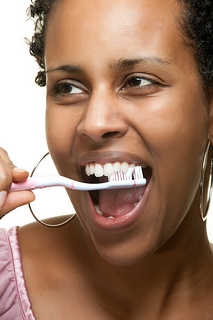
One of the most transformative advancements in dental restorations is the dental implant. Implants look just like natural teeth, they function just like natural teeth, and they help maintain jawbone health just like natural teeth. But the success of any implant procedure depends on the quality and quantity of the bone in which it’s placed. That’s why, before placing your implant, Doctors Bauer, Lawrenz, and Stark might first suggest a common procedure known as ridge modification.
An implant consists of a metal post which is surgically placed in the jawbone. This post serves as the “root” of the dental implant. After several months, the post fuses with the bone surrounding it, as bone tissue grows around and attaches to the post surface. This process is called osseointegration, and it creates a strong, secure anchor for the abutment and crown which will be secured to the post when it heals.
Because of the strong pressures which biting, chewing, and clenching put on our teeth, the success of an implant depends on the strength of its integration into the jawbone. To make osseointegration possible, the bone must be healthy, with adequate size and density to hold the implant securely.
Ridge modification, also called ridge augmentation, is periodontal surgery. In this procedure, we use bone grafting to rebuild bone strength in the alveolar ridge (the part of the jawbone containing the tooth sockets) before placing a post. When is this procedure necessary?
Jawbone size and density can be compromised in several different ways, including:
When a tooth is missing, the bone ridge under the lost tooth gradually begins to shrink, a process called “resorption.” Over time, bone loss can lead to a noticeable indentation in the jawbone.
Serious gum disease is progressive. Without treatment, the gums begin to pull away from the teeth. This leaves bone and connective tissue exposed to destructive bacteria and infection, which can cause bone loss.
Bone damage caused by accident or injury might require bone replacement or recontouring.
Sometimes the jaw ridge is too narrow or shallow to support an implant, especially in the back of the upper jaw near the sinus cavity, and will need added bone before an implant can be placed.
Periodontists are specialists in bone grafting surgery, with years of advanced education and training in the treatment of the structures that support the teeth, including gums, connective tissues, and bone. Doctors Bauer, Lawrenz, and Stark will recommend bone graft surgery if the success of your implant would be in jeopardy without it.
What will your surgery involve?
- Assessing bone quantity and quality
Using advanced imaging technology, we will evaluate your jaw’s condition, and map out any areas of bone loss.
- Designing your treatment plan
If a bone graft is your best option, we will recommend the best grafting materials for your needs. Bone grafting might use bone tissue taken from your own body, processed bone grafting material, or synthetic grafting material to replace and repair the damaged bone. We will also discuss your anesthesia and sedation options.
After anesthesia, an incision will be made in the gum tissue to reveal the damaged or missing bone. Grafting material will be shaped to restore the bone’s contours and secured to the affected area. The incision will then be closed. If you are here for an extraction, it may be possible to have augmentation done as part of the same procedure.
You’ll receive detailed careful instructions for after care and follow-up visits at our Champlin, MN periodontal office. The time it takes for you to heal completely will depend on the size and type of your graft.
Once the bone has healed, we can surgically place the post for a secure, long-lasting, and healthy implant.
If it’s been some time since you lost a tooth, if your jaw has been damaged by injury or trauma, if you have less-than-adequate bone size and density, it’s important to restore your bone before implant surgery can be successful. See us for an evaluation, and learn how a ridge modification procedure can help you improve your dental health and transform your smile.





 Website Powered by Sesame 24-7™
Website Powered by Sesame 24-7™